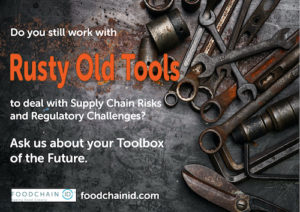Automated Risk Assessment for Food and Beverage Ingredients
Our partner Mintec published this article in their monthly Market Movers Newsletter.
Contaminated and adulterated ingredients that may endanger the health and safety of consumers are a nemesis for food and beverage manufacturers. Costly recalls often follow, resulting in significant expenses and loss of reputation for food producers. With more and more complex raw material supply chains, today’s producers are facing unprecedented challenges to monitor risks very closely from all angles. From biological to chemical substances, to adulterants, to physical hazards, such contaminants compromise the safety and quality of food.
The first step of ingredient risk mitigation is the identification of the threats, followed by an assessment of the directly affected products in a company’s portfolio. Several tools are available today that gather data for ingredient risk assessment. FoodChain ID’s Food Fraud Database collects and standardizes risk information for economically motivated food and beverage adulteration (food fraud) in thousands of ingredients. EMAlert™ shows the relative risk for food fraud for commodities, and also provides a look into future risk for economically motivated food adulteration. In addition, HorizonScan™ by Fera is able to monitor daily notifications for impurities, contaminants and other hazards in over 600 food commodities. Identification of a company’s affected suppliers is the next step in ingredient hazard mitigation, followed by ranking and prioritizing the threats, and a focus on the most burning issues.
With all these data streams on food ingredient risk available, how does the food industry efficiently assess risks in a complex supply chain that may involve hundreds or thousands of raw materials? We ran a case study with a limited number of 50 products. Note that often, however, companies have several thousand ingredients. This 50-product example already generated an astonishing number of over 65,000 risk assessment reports per year. Quality Managers cannot keep up with the manual analysis of such a data flood, often catching only 5-10% of problems. Companies therefore appreciate the availability of an automated solution which bundles these data streams.
How can companies rank and prioritize supply chain threats? Sentinel, FoodChain ID’s computerized mapping tool, can generate a risk score by performing automated daily comparisons of a company’s ingredients and products generated by the HorizonScan™ system. The Food Fraud Database and the EMAlert food fraud vulnerability assessment tools can also be connected into one convenient dashboard to display ingredient risks in one glance, updated daily. Sentinel’s automated and customizable solution allows a company’s quality control to detect problems on a global basis, and mitigate food ingredient threats before they become bigger problems.
In addition to ingredient risks, New Product Development (NPD) processes also benefit from automation throughout the ingredient supply chain. With the acquisition of Hamilton Grant, FoodChain ID is able to provide a sophisticated system that streamlines NPD from a company’s suppliers to its customers. A web application connects directly to suppliers who can directly enters raw material specifications, ensuring that data only needs to be entered once in the process. This tool is able to update critical information in real time, including nutritional information, allergens, ingredient lists, costs, and compliance checks. The customer can choose label data sheets and finished product specification. This system streamlines data collection, eliminates the need to fill out forms and keeps all ingredients and data up-to-date and accurate.
Contact us today to learn how our sophisticated tools can help you with quality control and product development.

Posted on 3 November 2021
